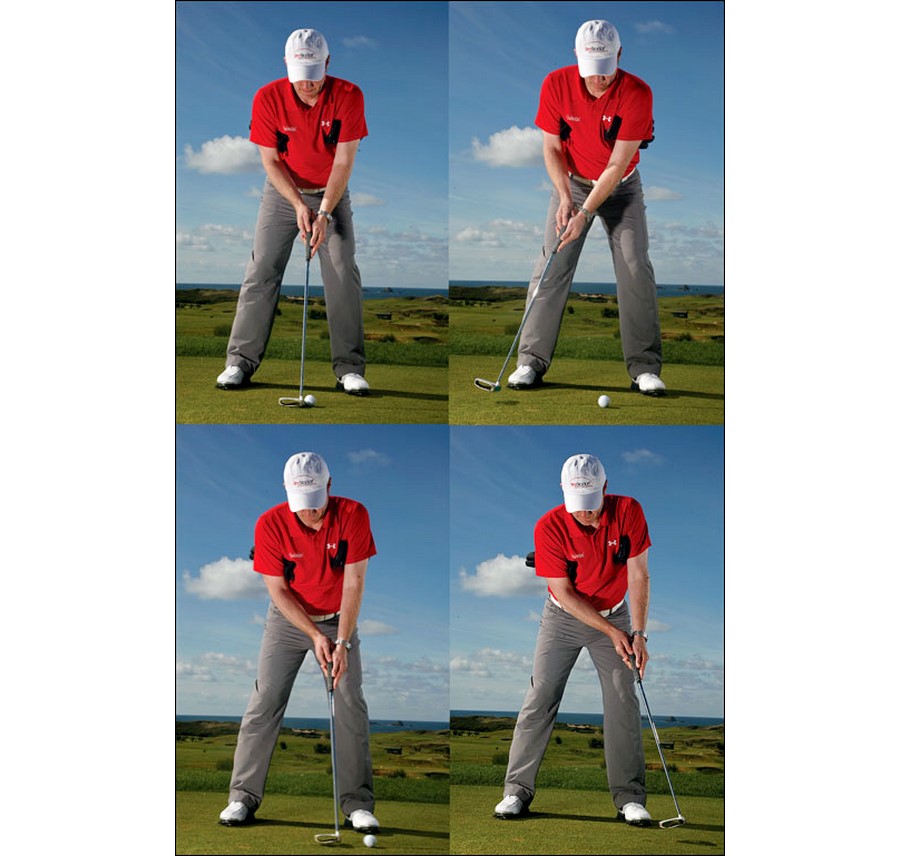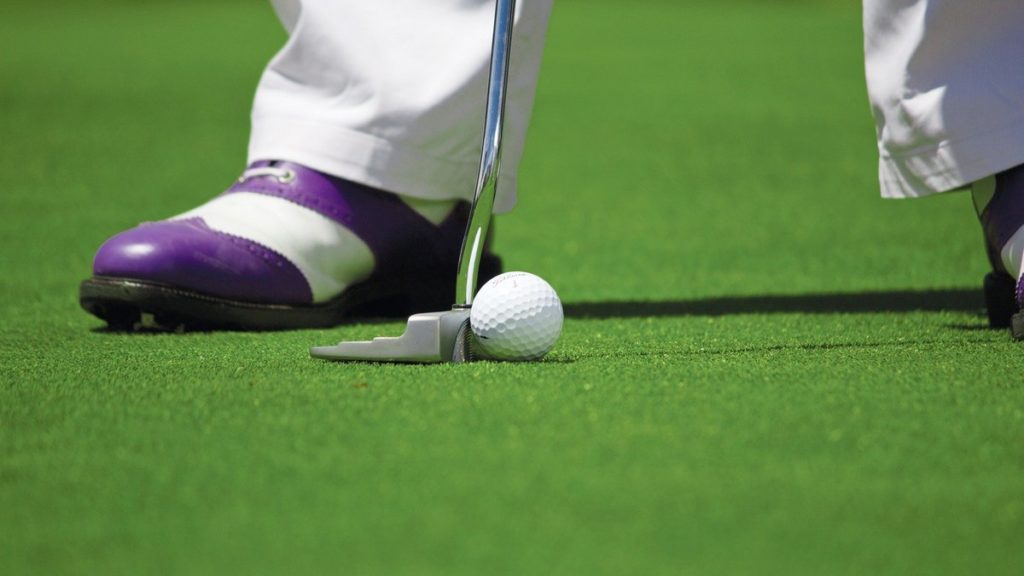The best putters in the world eliminate unnecessary movement and hone a stroke that is built around the stability of a consistent platform. Key to achieving that is a stable pelvis – and improving that alone will make you a better putter the next time out
– Dr Paul Hurrion
Putting represents half the strokes played in the average round of par golf and is, in many ways, a miniature version of the full swing – yet, perplexingly, it remains the area of the game least taught, least seriously practised and, perhaps, least understood. the majority of coaching features and videos, manuals and textbooks suggest ‘feel’ as the key to success, along with a good technique. However, thinking logically, a good technique must surely come first in order to create the consistent platform necessary to replicate the stroke that enables you to develop the ‘feel’ to hole putts. So, what factors contribute to a good technique?
Strength may not spring to mind, but I am of the firm belief that putting is a strength exercise. It is strength which gives you a stable posture and balanced pivot point – essential to the putter being returned consistently to impact from address.
It is also often advised by golf teachers that it is best to stand comfortably at address and relaxed over the ball prior to hitting the putt. However, it has been my experience that ‘comfortable’ does not necessarily translate into well-balanced and (potentially) creates an individual style of putting which often encourages (and indeed requires) a degree of manipulation during the stroke. I believe one of the fundamentals to good putting is a strong, balanced set-up, and over the following pages I will introduce three specific drills designed to help you improve that quality in your own game. they will help you create that sound base for a consistent strike (and that same sound base will help the rest of your game, too).
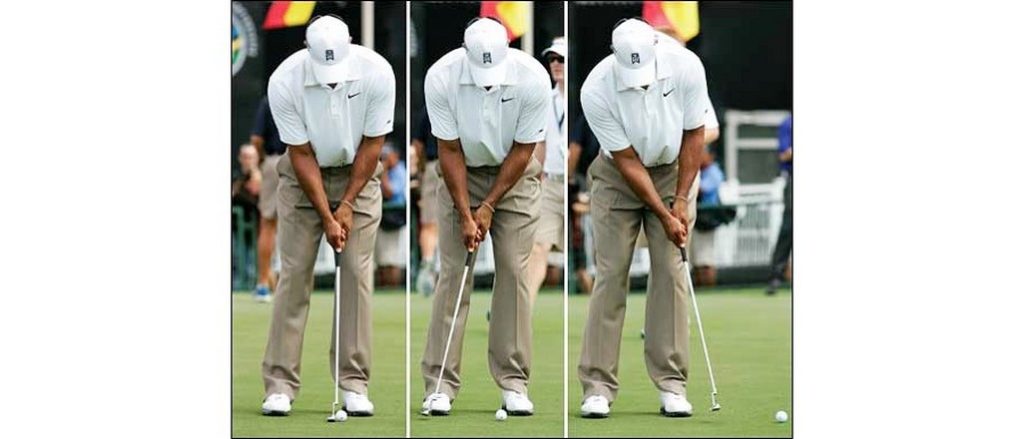
At Quintic, we recently carried out research to study the set-up position of 30 elite Pga professional golfers and 30 amateur golfers (handicaps ranging from +3 to 9), all of whom were filmed whilst attempting the same level 20-foot putt on a surface with a stimp reading of 12. all 60 performed their regular putting action with their own putters whilst standing on an rSscan Footscan pressure measuring platform. the results were interesting. We found that there was a difference between the amateur and professional groups in set-up; the weight distribution of the amateurs was approximately 60:40 (in favour of the right side for right-handed golfers), whilst the professionals were much closer to 50:50 at set-up.
there was also a trend to suggest that the wider the stance, the smaller the centre of pressure movement (i.e. sway) during the stroke. and although there was no appreciable difference in stance width between the two groups of players, there was a noticeable difference in the amount of sway, with significantly more movement seen in the amateurs. as you will appreciate, the more (lateral) body movement, the more the likelihood of inconsistency in terms of the path and tempo of the putting stroke – factors that contribute to inconsistency at impact and a loss of feel.
So, as ever in this game, the key is to get yourself correctly positioned at the set-up.
Let’s get to work.
Use a cane to hone this vital discipline
It is the pelvis that has a tendency to sway, so firstly, you will want to see or measure that unwanted movement during the putting stroke. Not all golf coaches have access to a pressure platform, but as an alternative, a simple cane through the belt loops of your trousers can be your visual key.
How is your pelvis aligned relative to the ground? This will give you a good indication of the weight distribution on your left and right feet. Focus on achieving a horizontal pelvis to create a stable lower body. As with a full swing, the object is to rotate your torso, shoulders and arms around your spine – your pelvis is the base for your spine and so a stable pelvis is vital for effective and consistent rotation. [Note: in the main image (left) you will see the cane is pointing slightly down, towards the target, indicating a fraction more weight – 55:45 – in favour of the left side.]
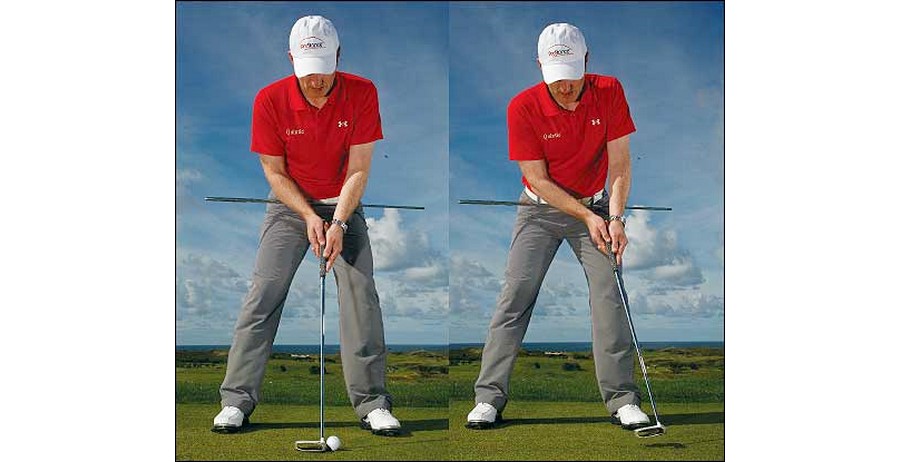
Maintain angles and stay ‘in the putt’ – no peeking!
How often do golfers finish in the position you see below? The pelvis has rotated open, and the shoulders inevitably follow suit.
As a result, the eyes beat the strike and the ball misses left. The cane gives a visual image of how much the pelvis has opened during the stroke and at the finish! It is also possible to video the cane to quantify the amount of movement in degrees, the key on the video is to look for the first sign of movement, where in the sequence of the stroke does movement occur?
‘Cover the ball’ (by this I mean your eyes remain fixed above the ball), trust your set-up alignment, and ‘stay in the putt’. The lower body remains stable after impact (see the correct position). The aim for my golfers is to create a consistent and repeatable putting action that enables them to start the ball on the line that they have read, at the required pace, every time and under pressure! Therefore they appreciate the vital importance of a stable and solid base right through the putting stroke providing the fixed pivot point from which they can execute a consistent stroke… and develop the feel for holing putts.
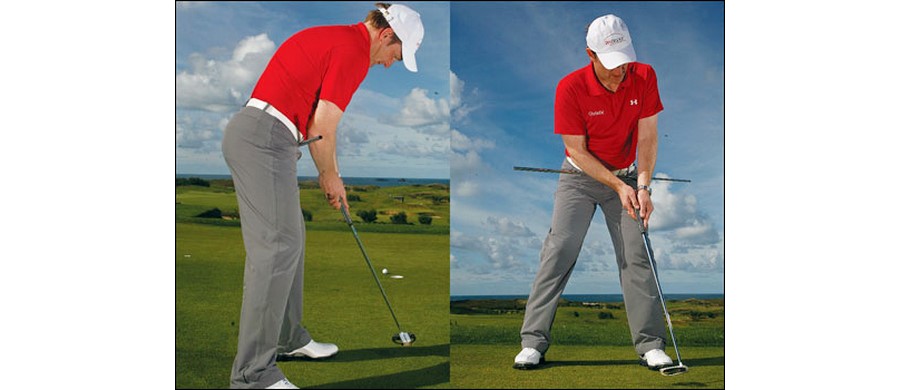
In my research and coaching I use high-speed cameras that record up to 10,000 frames per second to show the details of the movement we simply cannot see with the naked eye at regular speed. This provides vital information that allows us to correlate movement of the body and the putter with the behaviour of the ball as it leaves the face of the putter. It becomes so obvious that the more the body moves, the more I see manipulation of the putter head in an attempt to get the putter to square impact on a straight path – and it is that manipulation that leads to a player’s inconsistency.
I want my students to eliminate manipulation by having a solid and balanced set-up position for perfect symmetry and control allowing the putter to strike squarely down the line and out of the middle of the face every time.
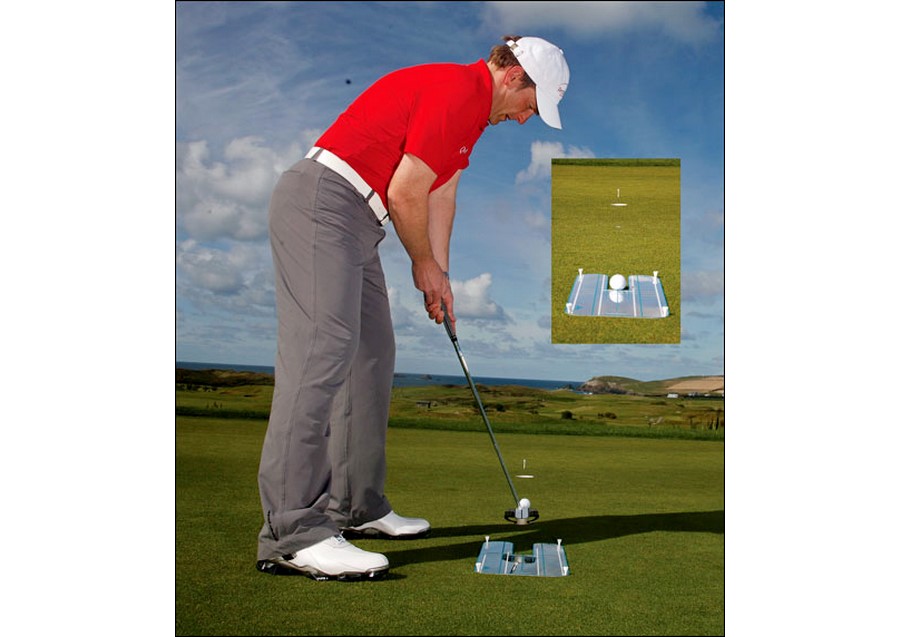
Prostance creates the challenge of finding your balance
Stability comes from strength and balance. In my coaching I use the ProStance balance aid (www.pro-stance.com), an inflatable tube which is placed under the arches of the feet to create an instant challenge and feedback mechanism. It is a simple but effective game improvement tool which heightens the brain’s awareness of the body’s balance and its control of the relevant muscles. The ProStance gets to the heart of two key fundamentals: static and dynamic balance. It fine-tunes your balance as you get into the set-up posture and maintains it throughout the motion of the stroke. In biomechanical terms, the ProStance helps you determine how much to flex your knees and ‘fix’ your posture (and, importantly, your pelvis) so that you learn to keep the core of your body (i.e. pelvis and spine) perfectly stable during the stroke.

(centre) ‘Floating feet’ in a bid to find the perfect balance point
(right) Tipping your weight forwards places excessive pressure on the toes, a fault that often leads to a stroke that is outisde-to-in, cutting across the ball
The more you inflate the tube, the harder it is to achieve and then maintain good balance – and that’s the key to the exercise. As you put your body under pressure, your brain instinctively causes your muscles to adapt to the threat of being out of balance, and you will flex your knees and stick out your rear end to balance and settle your weight. Rocking backwards applies too much pressure to the heels (above left), while tipping the posture forward (above right) places excessive pressure on the balls of the feet. I want the weight to be evenly distributed through your arches and I want you to feel as comfortable as if your toes and heels were in contact with the ground.
Equal pressure across both feet (i.e. above centre) confirms perfect balance; it also ensures you are correctly aligned in the optimal position to give you that stable pelvis. Hit a few putts. After a bit of determined practice, your brain subconsciously learns to fine-tune your physical movements and achieve a relaxed but balanced state. As you become more relaxed, inflate the tube further to challenge your brain and body to respond. Finally, step off the ProStance and hit some putts with your feet on the ground. You will feel your feet react with the ground and appreciate the foundation of a truly balanced base upon which you can base a smooth putting stroke.
The graphic below is a pressure plate readout of weight distribution for a tour professional at address with a putter, both before and after strength exercises and coaching with the ProStance balance aid. Note the percentage recorded for each quarter and the central red dot with a small white tail. The before image (top) highlights the golfer’s weight falling backwards during the putt (the white tail below the central red dot is the trace of body moving away from the centre during the stroke).
After working with ‘ProStance’ the body weight is better distributed and most importantly, the after image shows almost perfect stability during the putting stroke (minimal tail on the red dot). As a result the body mechanics have changed with improved knee flexion and spine angle due to being in great balance!
Why do I keep saying that the consistency of the address position is vital for long-term success? Well, putts are never on a completely flat green, so your brain is always asking your body to compensate for each different set-up position. The necessary information comes from kinaesthetic feedback – the perception and feel of the surroundings, surface, slopes, contours, wind etc. It is logical that the brain and body can make the necessary adjustments more accurately from a practised consistent, powerful base than from a wavering platform – and strength and balance are the key
Put your balance on the spot with this practice drill
This is a great (and not so easy as it looks!) drill that you may have seen Rory McIlroy rehearsing if you have been lucky enough to see him at a tournament recently – it still forms part of his practice routine.
Address the ball in line with the little toe on your left foot (speaking for a right-handed player), and find your balance with your right foot up in the air. The first challenge is to hold this position for 30 seconds without resting your club on the ground for stability! The aim of the drill is then to make the stroke and maintain your balance and stability on the one foot. Stroke the putt and hold your finish for 3 seconds after impact.
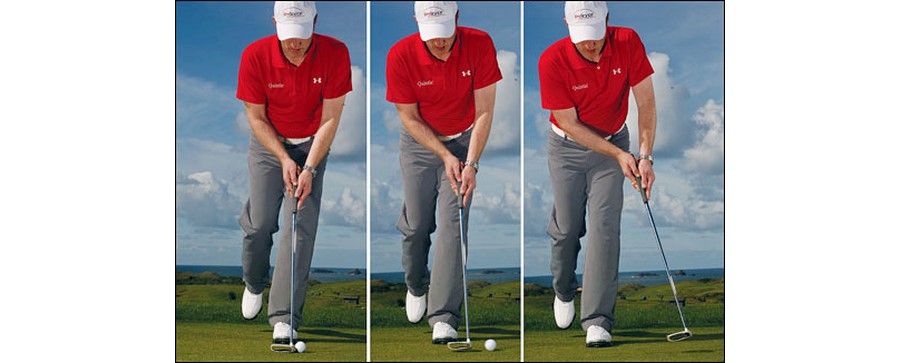
Remember, the key here is that you ‘cover the ball’, ensure your pelvis is stable and the shoulders and torso rock around the spine.
Gather 6 balls and make 6 putts without putting your right foot down. Hit the first putt, bring the second ball into position still on one foot, hit and hold for 3 seconds. Continue for all 6 putts. (Feel the ache in your left ankle? Good.
The drill is working – and the more you practice, the stronger that ankle will get).
The majority of golfers will back off during transition or the through-swing and as a result will topple backwards needing to put their right foot down (inset left).
This is also a great drill for pace control. Pace is a result of controlled energy transfer from the body into the club – which is why it is so important to swing through the ball – not hit at it! The tempo of your stroke should remain constant even though the length of the stroke changes with the distance you want the ball to travel. Work on a smooth transition into the through-swing and solid, consistent contact with the ball.
The length of the backswing should equal the length of the through-swing (a relaxed grip pressure will help you achieve this). This will ensure equal effort in swinging the putter back and through. If the through-swing is more than 50% of the total length of the stroke, then, as a rule, more effort has been applied to the stroke on the downswing causing a loss of balance off the one foot. Take the opportunity to think about where this extra effort has come from? Do your shoulders open, do your wrists flip and add more loft to the putter? There are a number of factors that could occur. Remember, the key is to make your movement as efficient as possible and minimise manipulation.
I strongly advocate a safe, repetitive pendulum-style stroke focusing on the rocking motion of arms and shoulders – a stroke you can rehearse easily if you trap a glove high up under each armpit and keep it there as your practice (as per the images opposite). A stable pelvis at the base of a strong and balanced stance at the set-up (and through the stroke) will reward you with a consistent technique. Your brain will then take over and develop feel for the technique along with green reading skills that enable you to adjust to ever-changing conditions. The end result is that you are able to strike the ball on your chosen line and at the right pace – which means you will hole out more often.
Eyes closed heightens positive feelings
When (and only when!) you have mastered the one foot drill, try it with your eyes closed (main image)! When you lose one of your senses, the others automatically sharpen up to compensate, and you will find this adds another valuable dimension in terms of your feel for your stroke, where your balance originates, and the rhythm of your motion. All of which will further improve your stance, visualisation and confidence.
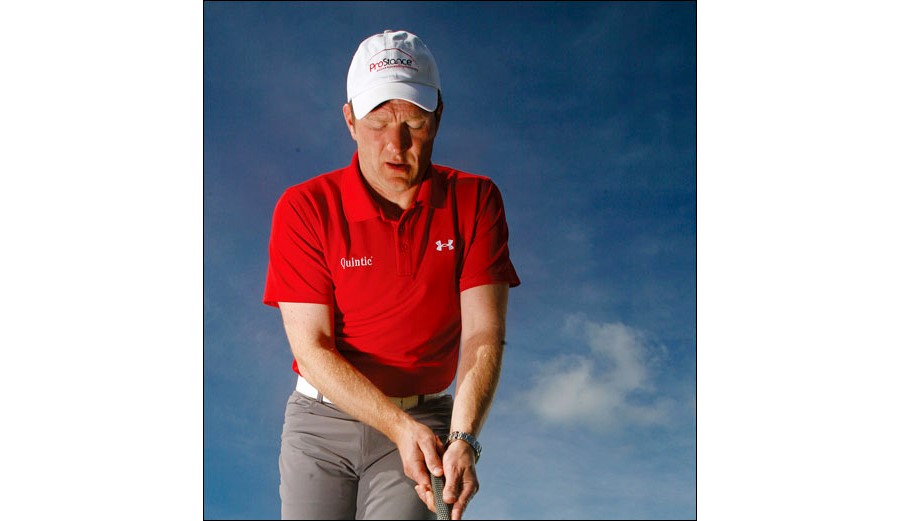
Stay ‘connected’ for a tick-tock pendulum motion
Let me leave you with one of the most effective drills that I know to develop and hone a trusty pendulum-type stroke. All you need are a couple of gloves, which you simply hold in place between your upper arms and torso. Maintaining the necessary pressure to keep the gloves in place will ensure that your arms and upper body work together to create a symmetrical stroke, one that is controlled by the gentle rotation of the shoulders. I hope you find the time to integrate these drills into your putting practice – and that all that hard work proves beneficial this season.
